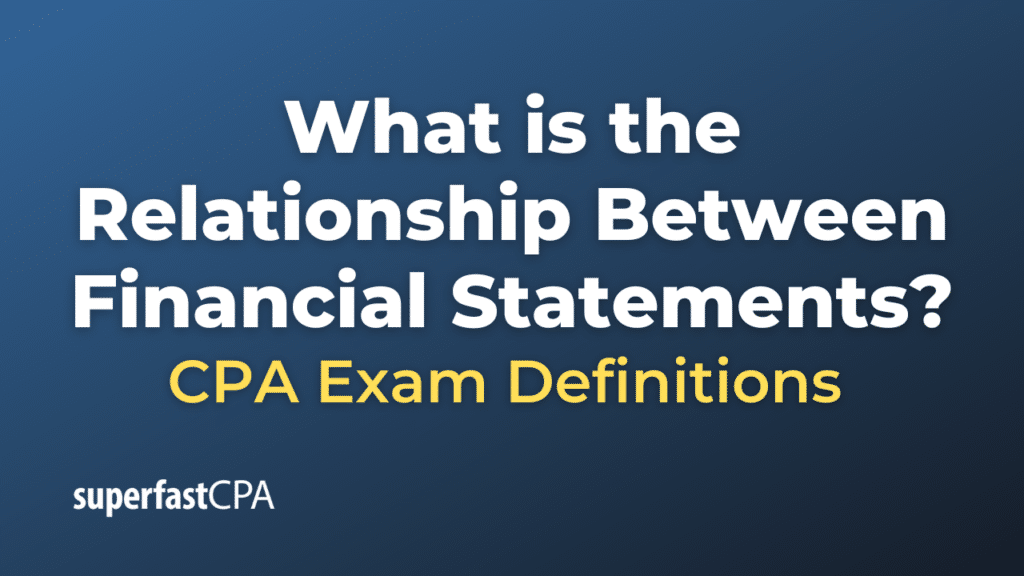Relationship Between Financial Statements
Financial statements are interrelated and provide a comprehensive view of a company’s financial health. The primary financial statements are the Income Statement (or Profit and Loss Statement), Balance Sheet (or Statement of Financial Position), Statement of Cash Flows, and the Statement of Changes in Equity. Let’s explore their relationship:
- Income Statement and Balance Sheet:
- The net income (or loss) from the income statement affects retained earnings on the balance sheet.
- Depreciation from the income statement reduces the value of assets on the balance sheet.
- Expenses that are accrued but not paid (like wages payable or interest payable) show up as liabilities on the balance sheet.
- Income Statement and Statement of Cash Flows:
- The bottom line of the income statement (net income) is the starting point for the operating activities section of the cash flow statement.
- Non-cash expenses like depreciation and amortization are added back to the net income in the cash flow statement.
- Balance Sheet and Statement of Cash Flows:
- Changes in current assets (like accounts receivable and inventory) and current liabilities (like accounts payable) between two balance sheet dates impact the cash flow from operating activities.
- Purchases or sales of long-term assets (like property or equipment) are reflected in the investing activities section.
- Changes in long-term liabilities or equity (like issuing or repaying debt, issuing or repurchasing stock) are shown in the financing activities section.
- Statement of Changes in Equity and Balance Sheet :
- The ending equity balance in the Statement of Changes in Equity is the same as the total equity reported on the balance sheet.
- Dividends declared reduce the retained earnings in the Statement of Changes in Equity and represent an outflow of equity.
- Statement of Changes in Equity and Income Statement :
- Net income or loss from the income statement impacts the retained earnings section in the Statement of Changes in Equity.
All these statements provide different angles of a company’s financial health. For instance:
- Income Statement gives a snapshot of a company’s profitability over a period.
- Balance Sheet shows a company’s assets, liabilities, and equity at a specific point in time.
- Statement of Cash Flows provides insights into a company’s cash inflows and outflows from its primary activities.
- Statement of Changes in Equity details the variations in the owners’ interest in the company over time.
To get a comprehensive understanding of a company’s financial situation, these statements should be reviewed collectively. They are all derived from the same accounting data and are just different representations of it. By understanding the relationship and flow between these statements, users can piece together a more complete and cohesive picture of a company’s financial performance and position.
Example of the Relationship Between Financial Statements
Let’s illustrate the relationship between the financial statements with a simple example.
Imagine a company named TechGuru Ltd. Here are some key financial activities during its first year of operations:
- Income Statement for the Year:
- Revenue: $500,000
- Cost of Goods Sold (COGS): $200,000
- Operating Expenses (including $10,000 of depreciation): $150,000
- Interest Expense: $10,000
- Net Income (Revenue – COGS – Expenses – Interest): $140,000
- Balance Sheet at Year-End:
- Assets:
- Cash: $80,000
- Accounts Receivable: $50,000
- Inventory: $30,000
- Property, Plant & Equipment (PP&E) (costing $100,000 with accumulated depreciation of $10,000): $90,000
- Liabilities:
- Accounts Payable: $25,000
- Long-Term Debt: $100,000
- Equity:
- Common Stock (initial capital injection): $100,000
- Retained Earnings (Net Income for the year): $140,000 (assuming no dividends were paid)
- Assets:
- Statement of Cash Flows:
- Operating Activities:
- Net Income: $140,000
- Adjustments for non-cash items: Add back Depreciation: $10,000
- Changes in Working Capital (like accounts receivable, inventory, accounts payable): Net negative cash flow of $70,000
- Net Cash from Operating Activities: $80,000
- Investing Activities: Purchase of PP&E: -$100,000
- Financing Activities: Proceeds from Long-Term Debt: $100,000
- Operating Activities:
- Statement of Changes in Equity:
- Opening Equity: $0 (since it’s the first year)
- Add: Common Stock issued: $100,000
- Add: Net Income for the year: $140,000
- Closing Equity: $240,000 (which matches the balance sheet)
Relationships Illustrated:
- Income Statement to Balance Sheet: The net income of $140,000 becomes retained earnings on the balance sheet. The depreciation of $10,000 reduces the carrying amount of PP&E on the balance sheet.
- Income Statement to Cash Flow : The net income of $140,000 is the starting point for the operating activities on the cash flow statement. The depreciation of $10,000 is added back since it’s a non-cash expense.
- Balance Sheet to Cash Flow: The change in accounts receivable, inventory, and accounts payable (components of working capital) impacts the cash flow from operating activities. The purchase of PP&E and the taking on of long-term debt are reflected in the investing and financing sections, respectively.
- Income Statement to Statement of Changes in Equity: The net income of $140,000 is added to the equity section.
- Balance Sheet to Statement of Changes in Equity: The total equity of $240,000 on the balance sheet matches the closing equity on the statement of changes in equity.
This example showcases how financial events and figures from one statement connect to and influence the other statements, painting a comprehensive picture of TechGuru Ltd.’s financial position and performance.













